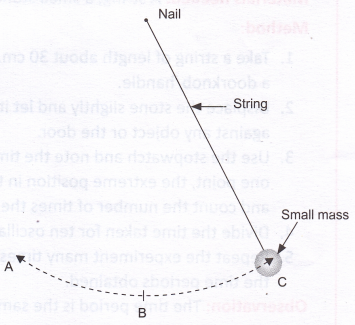Measurement of Time Using Periodic Motion
Any object that is moving is said to be in motion. In order to measure time, we need a motion that repeats itself in equal intervals. Such a motion is called periodic motion.
Some examples of periodic motion are the rotation of the Earth about its axis, the revolution of the Earth around the sun, the revolution of the moon around the Earth, the to-and-fro movement of a spring, and the oscillation of a pendulum. These types of periodic events are used to make clocks and calendars. Some of the first accurate clocks were based on the periodic movement of a pendulum.
Simple Pendulum
A small mass that is suspendedfrom a fixed point and allowed to swing freely under the influence of gravity is called a pendulum.
An ideal, simple pendulum consists of a small mass (like a stone or a metal ball) called a bob suspended by a string. When the bob moves from one position and returns to the same position, it is said to complete one oscillation. The time taken to complete one oscillation is called the time period of the pendulum. For example, if the bob starts from point A, goes to points B and C, and returns to point A, it completes one oscillation.

By studying the oscillations of a simple pendulum, the observations can be summarized as follows:
- The time taken by a pendulum to complete one oscillation (i.e., its time period) does not depend on the extent to which the bob of the pendulum is displaced.
- The time period does not depend on the mass of the bob used (within reasonable limits).
- The time period depends on the length of the string or wire used; greater the length of the string, greater is the time period (assuming that the string itself has negligible mass).
This means that if the length of the pendulum is fixed, its time period is constant. This was a wonderful discovery. Scientists began to build new clocks based on this property of the pendulum.
How fast or slow an object travels depend on the time it takes to travel a certain distance, it is closely related to the measurement of time. We will now discuss slow and fast motion, and how we can measure it.
Activity
Aim: To show the constancy of the time period of a pendulum.
Materials needed: A string, a small stone, a doorknob/handle, and a stopwatch.
Method:
- Take a string of length about 30 cm. Tie the stone to one end. Tie the other end of the string to a doorknob/handle.
- Displace the stone slightly and let it oscillate. Make sure it oscillates freely and does not rub against any object or the door.
- Use the stopwatch and note the time taken by the stone to complete ten oscillations. [Take any one point, the extreme position in the oscillation or the mean (middle) position of the stone and count the number of times the stone crosses this point, in the same direction.
- Divide the time taken for ten oscillations by 10. This gives the time period of the pendulum.]
- Repeat the experiment many times without changing the arrangement. Compare the value of the time periods obtained.
Observation: The time period is the same in each case.
Conclusion: This shows the constancy of the time period of the pendulum.